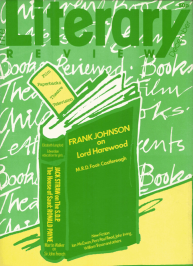Elizabeth Longford
Womanly Behaviour
Girls Growing Up in Late Victorian and Edwardian England
By Carol Dyhouse
Routledge&KeganPaul 224pp £8.95
There may be a recession but not in the women business. Our shelves are overflowing with encyclopedias devoted entirely to women, while women’s conditions are chronicled in every century down to our own. Indeed I must declare a modest family interest. Ms Fraser is working on ‘Seventeenth Century Woman’, Ms Billington has published A Woman’s Age, and I am in the midst of reading The Company of Women. With all this going for them, women must surely be well on the way to finding that holy grail of the twentieth century – their identity. If however they have still some distance to travel, this impressive short guide to forty years of girls’ history (1870-1910) will help them forward.
Not that Carol Dyhouse’s social study is feminist propaganda or dedicated to anything but the digging out and collating of Victorian and Edwardian fact and theory. It is full of sharp quotations from what might be called the women’s bloodstock stables of the modem age: the memoirs of Naomi Mitchison,

Sign Up to our newsletter
Receive free articles, highlights from the archive, news, details of prizes, and much more.@Lit_Review
Follow Literary Review on Twitter
Twitter Feed
It wasn’t until 1825 that Pepys’s diary became available for the first time. How it was eventually decrypted and published is a story of subterfuge and duplicity.
Kate Loveman tells the tale.
Kate Loveman - Publishing Pepys
Kate Loveman: Publishing Pepys
literaryreview.co.uk
Arthur Christopher Benson was a pillar of the Edwardian establishment. He was supremely well connected. As his newly published diaries reveal, he was also riotously indiscreet.
Piers Brendon compares Benson’s journals to others from the 20th century.
Piers Brendon - Land of Dopes & Tories
Piers Brendon: Land of Dopes & Tories - The Benson Diaries: Selections from the Diary of Arthur Christopher Benson by Eamon Duffy & Ronald Hyam (edd)
literaryreview.co.uk
Of the siblings Gwen and Augustus John, it is Augustus who has commanded most attention from collectors and connoisseurs.
Was he really the finer artist, asks Tanya Harrod, or is it time Gwen emerged from her brother’s shadow?
Tanya Harrod - Cut from the Same Canvas
Tanya Harrod: Cut from the Same Canvas - Artists, Siblings, Visionaries: The Lives and Loves of Gwen and Augustus John by Judith Mackrell
literaryreview.co.uk